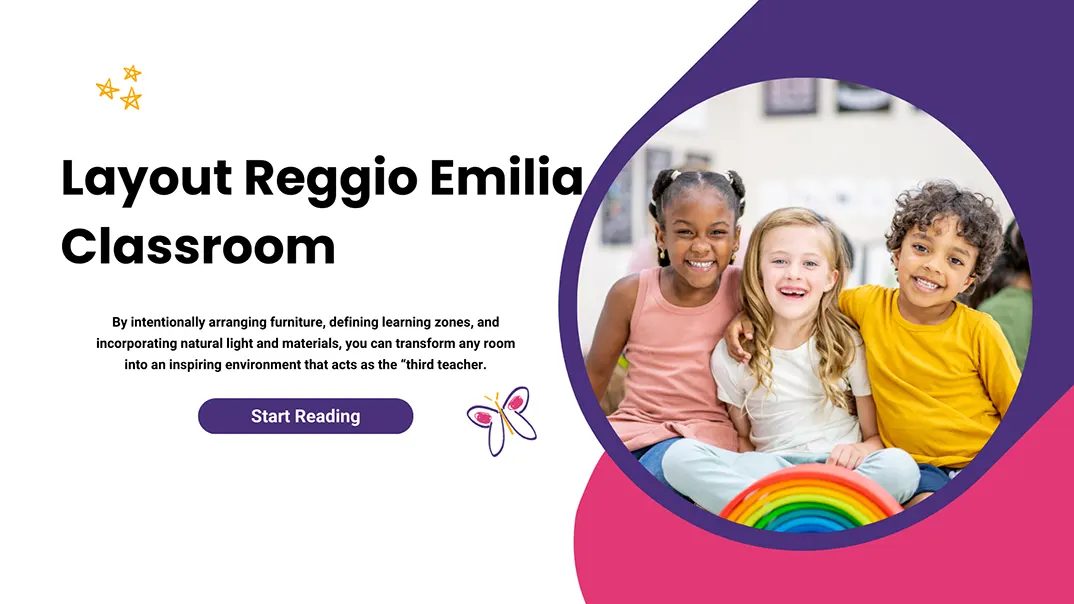Have you ever wondered why some classrooms inspire children to explore, create, and collaborate, while others feel limiting and uninspiring? Many educators and parents hear about the benefits of a Reggio Emilia classroom but struggle to translate its philosophy into an actual learning space. How can you arrange furniture, choose materials, and design the environment to reflect the Reggio Emilia approach?
A well-planned Reggio Emilia classroom layout is the foundation for fostering creativity, independence, and community among young learners. By intentionally arranging furniture, defining learning zones, and incorporating natural light and materials, you can transform any room into an inspiring environment that acts as the “third teacher.”
This article will guide you through planning your space, from identifying core principles to creating a functional and beautiful layout that reflects the Reggio Emilia vision. Keep reading to discover how to turn your classroom into a dynamic, inviting space where children’s ideas and creativity can truly flourish.
What Is a Reggio Emilia Classroom?
A Reggio Emilia classroom is a thoughtfully designed learning environment rooted in the Reggio Emilia approach to early childhood education, which originated in the town of Reggio Emilia, Italy, after World War II. It is based on the belief that children are capable, curious, and full of potential, and that their environment should actively support their exploration and learning.
Unlike traditional classrooms, a Reggio Emilia classroom layout is not static. It evolves alongside the children’s interests and projects, functioning as a “third teacher” that encourages inquiry, collaboration, and creativity. Every detail—furniture placement, educational materials provided, lighting, and even wall displays—is intentionally chosen to reflect and extend children’s learning.
In essence, the goal of a Reggio Emilia classroom is to create a setting where children’s voices shape the learning process, the physical layout supports creativity and critical thinking, and the environment itself reflects the values of respect, community, and curiosity.
Benefits of a Reggio Emilia Classroom Layout
A thoughtfully designed Reggio Emilia classroom offers far more than aesthetic appeal—it actively shapes the quality and depth of children’s learning experiences. When the classroom is seen as a responsive, interactive space, it nurtures children’s natural desire to explore, make connections, and construct meaning. Below are some of the most impactful benefits of implementing this approach to classroom layout:
- Creates a Sense of Belonging and Calm
Natural lighting, warm colors, and soft textures help foster emotional security and a peaceful learning atmosphere. - Fosters Independence and Decision-Making
Materials and spaces are designed to be accessible, allowing children to choose activities and direct their learning paths without constant adult intervention. - Encourages Collaboration and Communication
Open layouts and shared work areas invite social interaction and cooperative play, helping children develop essential social and language skills. - Inspires Creative Thinking
Including loose parts, natural elements, and open-ended materials sparks imaginative play and problem-solving. - Supports Deep Inquiry and Exploration
The layout of a Reggio Emilia classroom allows for long-term projects and investigations, providing space to revisit and expand on ideas over time. - Makes Learning Visible
Children’s work is documented and displayed, creating a living archive of their growth and discoveries, and reinforcing the value of their thoughts and expressions. - Adapts to Evolving Interests
Flexible spaces can be rearranged or reimagined to align with children’s current curiosities, making the classroom dynamic and ever-relevant.
Principles of Reggio Emilia Classroom Design
Creating an effective layout Reggio Emilia classroom requires thoughtful alignment with the guiding principles of the Phương pháp tiếp cận Reggio Emilia. Here, the classroom becomes more than a backdrop—it transforms into an active collaborator in a child’s educational journey. From aesthetics to adaptability, every design choice is intentional, grounded in a deep respect for the child, and aimed at fostering curiosity, agency, and connection.
Môi trường như người thầy thứ ba
In the Reggio Emilia philosophy, the physical environment plays a pedagogical role. It acts as the “third teacher,” shaping behaviors, guiding exploration, and promoting autonomy. A well-planned layout Reggio Emilia classroom uses design to communicate expectations, support routines, and invite independent discovery. Carefully arranged spaces foster children’s natural learning rhythms without direct instruction.
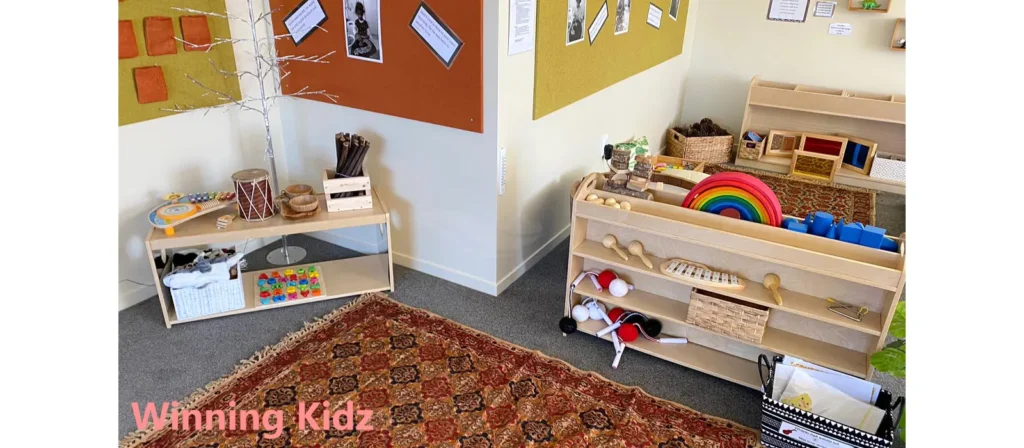
Intentionality in Every Element
Nothing in a Reggio Emilia classroom layout is placed arbitrarily. Each material, piece of đồ nội thất nhà trẻ, and learning area is chosen and positioned with purpose. Spaces are organized to encourage hands-on engagement, problem-solving, and imaginative thinking. Materials are placed at children’s eye level, accessible and appealing, so they naturally draw children into exploration.
Incorporation of Natural Materials
Organic materials—wood, stones, plants, clay, shells—add beauty, texture, and sensory depth to the learning space. These elements bring the outdoors inside, encouraging calm, grounded interactions and offering a contrast to overstimulating plastic toys. In a layout Reggio Emilia classroom, natural materials are not simply decorative—they’re educational tools that inspire connection and care for the environment.
Natural Aesthetics
Reggio classrooms are designed to be beautiful, not for appearance alone but to promote emotional safety, attention, and joy. A Reggio Emilia classroom layout often features neutral color palettes, soft lighting, and open spaces that are uncluttered and visually inviting. This aesthetic fosters a sense of calm, which supports concentration and creativity.
Hãy gửi tin nhắn cho chúng tôi nếu bạn có bất kỳ câu hỏi nào hoặc yêu cầu báo giá. Các chuyên gia của chúng tôi sẽ trả lời bạn trong vòng 48 giờ và giúp bạn chọn đúng sản phẩm bạn muốn.
Visibility and Transparency
Transparency is vital to community connection and reflective learning. Classrooms often use mirrors, glass walls, open shelving, and see-through containers to make materials and children’s work visible. In a Reggio Emilia classroom layout, children can observe one another, revisit their projects, and draw inspiration from peer activities—strengthening their understanding of themselves as learners.
Open-Ended Exploration and Play
Reggio Emilia classrooms are rich with loose parts and open-ended materials that invite infinite interpretations. Children are encouraged to experiment, combine, and transform items freely. The layout of a Reggio Emilia classroom supports this by offering ample space for imaginative construction, artistic expression, and inquiry-based play, without the constraints of rigid activity stations.
Flexibility and Adaptability
A Reggio-inspired classroom must evolve with the children it serves. As their interests shift, so should the environment. Mobile furniture, rearrangeable learning zones, and transformable areas allow the layout of a Reggio Emilia classroom to stay responsive and fresh. This adaptability keeps learning authentic and aligned with children’s real-time inquiries.
Collaboration and Community Building
Social interaction is central to learning. Layouts are designed to support group work, dialogue, and shared discovery. Circular seating, communal tables, and open floor spaces encourage collaboration. A Reggio Emilia classroom layout becomes a hub of collective creativity, where learning is co-constructed through communication and mutual respect.
Questions to Consider Before Designing a Reggio Emilia Classroom
Before arranging furniture or setting up learning zones, it’s essential to pause and think through some key questions. These considerations will ensure your layout Reggio Emilia classroom is not only beautiful but also aligned with the approach’s philosophy and practical needs.

What Are My Educational Goals?
- What kinds of learning experiences do I want to support—collaborative projects, individual exploration, or a balance of both?
- How will the classroom promote independence, creativity, and critical thinking?
Who Will Be Using the Space?
- What are the ages, developmental stages, and number of children in the group?
- Are there specific needs (e.g., accessibility, sensory sensitivities) to account for?
How Will the Space Reflect the Reggio Emilia Philosophy?
- In what ways can the environment act as the “third teacher”?
- How will I incorporate natural materials, child-led displays, and flexible spaces?
What Are the Physical Characteristics of the Room?
- Where are the doors, windows, fixed installations, and sources of natural light?
- How will I use or adapt these features to support different zones?
What Learning Zones Are Essential?
- Which areas will best support the curriculum?
- How will these zones connect and flow into each other?
What Resources and Budget Are Available?
- Do I have the furniture and materials needed, or will I need to source them?
- Which daycare furniture supplier should I choose?
- How can I make cost-effective choices without compromising the Reggio vision?
How Will I Document and Share Learning?
- Where will I display children’s work and learning processes?
- How will I ensure documentation is at the child’s eye level and easily accessible?
How Will I Adapt Over Time?
- What strategies will I use to update or rearrange zones as children’s interests evolve?
- How will I involve children in decision-making about the space?
Step-by-Step Guide to Designing a Reggio Emilia Classroom
Designing a Reggio Emilia classroom is a creative process that blends educational philosophy with practical design choices. By following a clear sequence—from vision to execution—you can create an environment that not only looks beautiful but also actively supports children’s learning and independence.
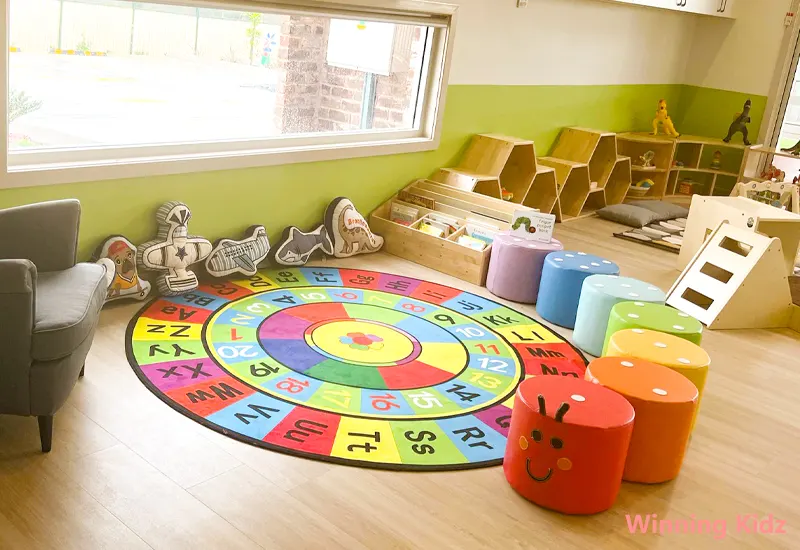
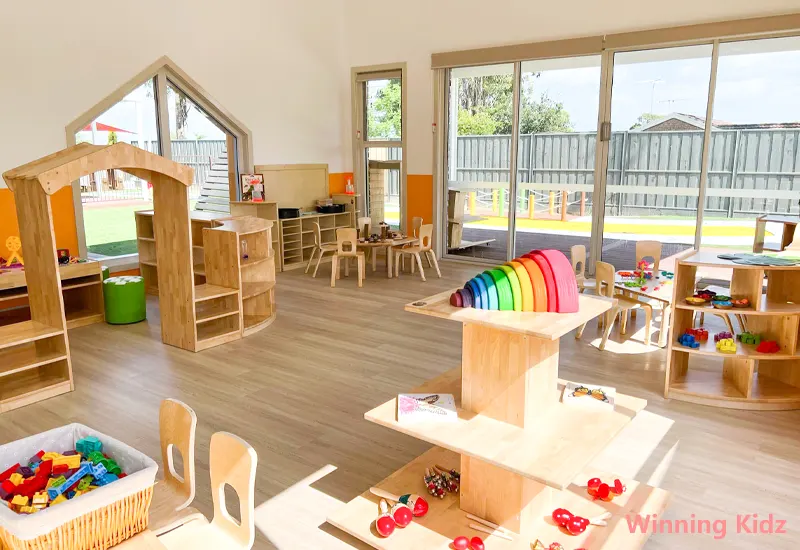
1. Define Your Vision and Purpose
Begin with the big picture. Ask yourself what values and learning experiences you want the space to promote. In Reggio Emilia, the environment should invite curiosity, collaboration, and self-directed exploration. This vision will guide every design decision you make.
2. Assess the Existing Space
Measure your classroom, map out fixed features, and note natural light sources. Identify high-traffic areas, storage needs, and potential safety concerns. Taking photographs or creating a simple floor plan will help you visualize different configurations before moving furniture.
3. Create Distinct Learning Zones
Zones give structure without locking children into rigid routines. They allow for focused activities while keeping the environment flexible. Determine where each zone will be placed. Consider light, noise, and accessibility so children can move between areas with ease. Active areas should be positioned away from quiet zones to maintain a balanced noise level and overall flow.
4. Designing a Sample Floor Plan
Once you’ve decided on the different learning zones, the next step is to arrange them in a way that supports flow, accessibility, and interaction. A floor plan serves as your visual blueprint, helping you ensure that every space is used effectively while keeping the classroom flexible and responsive.
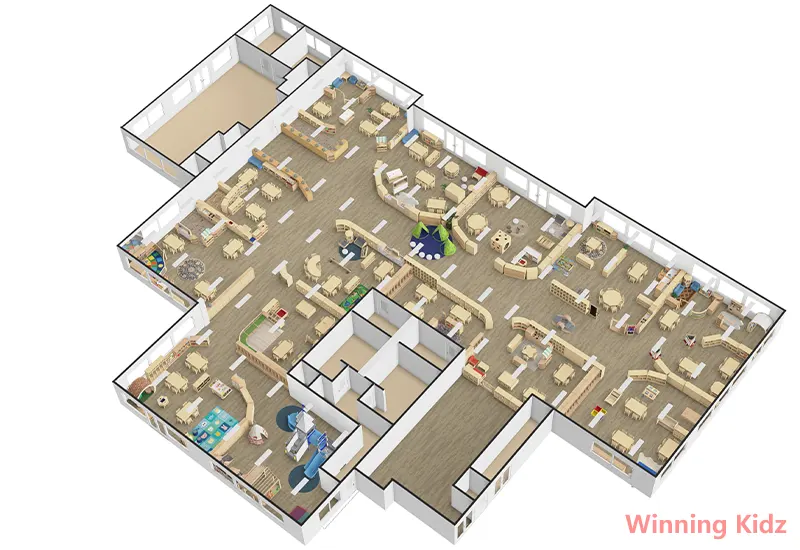
Start by marking fixed features such as doors, windows, and sinks on your plan. Position high-energy areas together so their activity doesn’t disturb quieter spaces. Place the atelier near a window or bright light and close to a sink for easy clean-up. Reading and calm corners work best in quieter areas, away from main pathways. The science and nature area should be near natural light to support plant growth and observation work.
5. Choose Materials and Resources
Select high-quality, natural materials that invite sensory exploration—wood, fabric, clay, and metal over plastic whenever possible. Keep resources accessible so children can make choices independently, fostering ownership of their learning environment.
6. Plan for Lighting, Color, and Acoustics
Maximize natural light, and use warm, soft artificial lighting for darker areas. Stick to a neutral, calming color palette that allows children’s artwork to stand out. Add rugs, fabric panels, or plants to improve acoustics and reduce noise.
7. Select Flexible Furniture and Storage
Opt for lightweight, movable pieces to support evolving projects. Use open shelving so children can see and reach materials easily. Incorporate labeled baskets or containers for easy cleanup and organization.
- Low tables for group projects.
- Mobile shelving units that double as room dividers.
- Stackable stools for easy storage.
8. Integrate Documentation and Displays
One of the hallmarks of the Reggio Emilia approach is making learning visible through documentation. Reserve prominent wall space for photo panels, project narratives, and children’s own words, transcribed and displayed alongside their work. Keep these displays at children’s eye level so they can revisit their learning and share it with peers and visitors.
9. Arrange and Test the Layout
Place furniture according to your plan, then observe how people move through the space. Make adjustments for better flow, visibility, or accessibility. Sometimes even small shifts in positioning can make a big difference.
- Are pathways wide and clear?
- Is supervision possible from multiple points in the room?
- Do the zones encourage engagement without overcrowding?
10. Involve the Children
Once the space is set, invite children to explore and give input. They might suggest where certain materials feel “right” or how they want to use an area. This not only empowers them but also ensures the classroom truly meets their needs.
11. Keep the Environment Evolving
A Reggio Emilia classroom is never static. As children’s interests grow and change, so should the space. Regular updates keep the environment stimulating and relevant.
Ideas for evolution:
- Rotate materials to introduce new challenges
- Rearrange zones to support current projects
- Add seasonal or cultural items that reflect the children’s community
Key Learning Zones in a Reggio Emilia Classroom
In a Reggio Emilia classroom, each learning zone serves as an intentional environment designed to support specific aspects of child development. These areas are not isolated “stations” but interconnected spaces that encourage movement, collaboration, and cross-disciplinary exploration. Below is a breakdown of each key zone, with its purpose, layout suggestions, and recommendations for furniture, toys, and materials.
Atelier (Art Studio)
The atelier is the creative heart of a Reggio Emilia classroom. It is a space where children can explore a wide range of artistic materials, express their ideas visually, and engage in long-term creative projects. The atelier fosters fine motor skills, self-expression, and aesthetic appreciation while encouraging children to think symbolically and represent their understanding of the world.
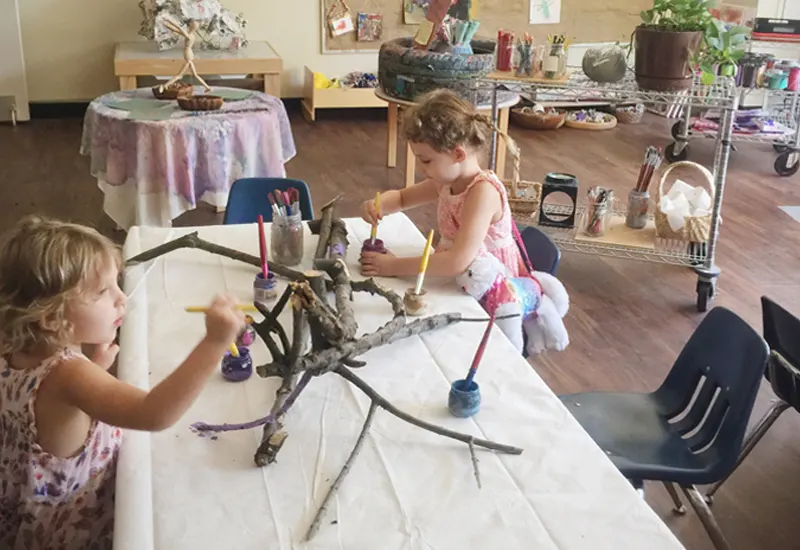
Recommended Furniture, Toys, and Materials
- Bàn ghế cỡ trẻ em
- Easels and drying racks
- Open shelving for art supplies
- Paints, brushes, and palettes
- Clay, modeling tools, and sculpting mats
- Recycled materials and loose parts
Layout Suggestions: Place the atelier in a naturally well-lit area, ideally near windows to benefit from daylight. Keep art supplies visible and within children’s reach to promote autonomy. Include a sink nearby for easy clean-up, and display artwork at the child’s eye level to celebrate creative achievements.
Khu vui chơi kịch tính
Các vở kịch area provides a stage for imagination, role-play, and storytelling. It allows children to explore social roles, practice language skills, and develop empathy through collaborative scenarios. This space supports cognitive, emotional, and social growth, making it an essential element of a child-centered classroom.
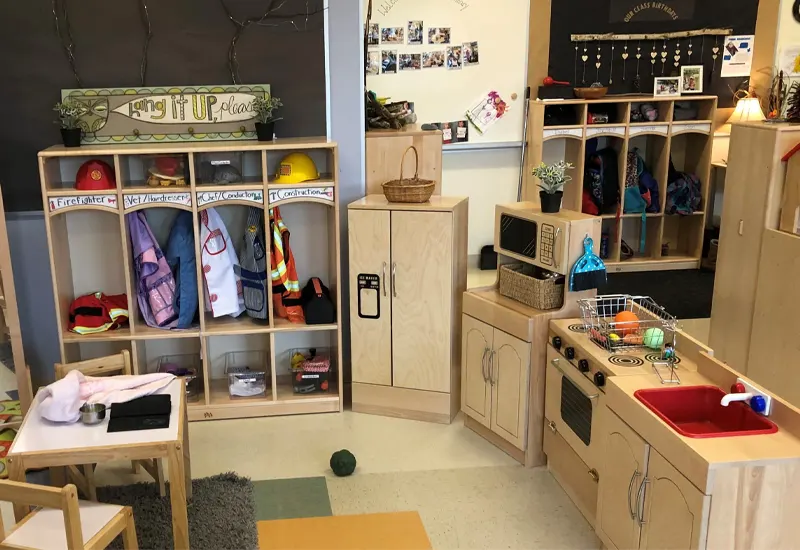
Recommended Furniture, Toys, and Materials
- Play kitchen with utensils
- Dress-up clothes and accessories
- Puppet theater and puppets
- Small tables and chairs
- Props for themed play (doctor kit, grocery items)
- Mirrors for self-reflection during play
Layout Suggestions: Position this area where children have enough room to move freely without disrupting quieter activities. Use partitions or low shelving to create a semi-enclosed space that feels like a “mini world” but remains visible to educators.
Classroom Reading Corner (Calming Corner)
Các reading corner is a calm, inviting retreat for children to enjoy books independently or in small groups. It nurtures a love for literacy, supports language development, and provides a space for quiet reflection. A well-designed reading corner can also encourage storytelling, peer reading, and a deeper appreciation of narrative structure.
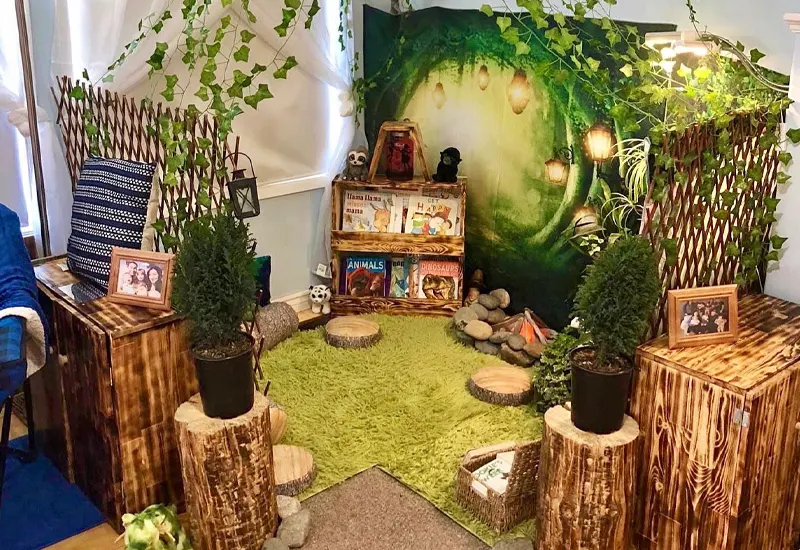
Recommended Furniture, Toys, and Materials
- Forward-facing low bookshelves
- Beanbags, cushions, or small couches
- Area rug for warmth and comfort
- Age-appropriate books in various languages
- Storytelling props and felt boards
Layout Suggestions:: Locate this zone away from high-energy areas to maintain a peaceful atmosphere. Use rugs, cushions, and low lighting to create a cozy feel, and ensure that books are displayed cover-forward to entice young readers.
Construction Area
The construction area encourages problem-solving, spatial reasoning, and cooperative play through building and engineering activities. Children develop creativity, resilience, and persistence as they test and refine their designs using open-ended building materials.
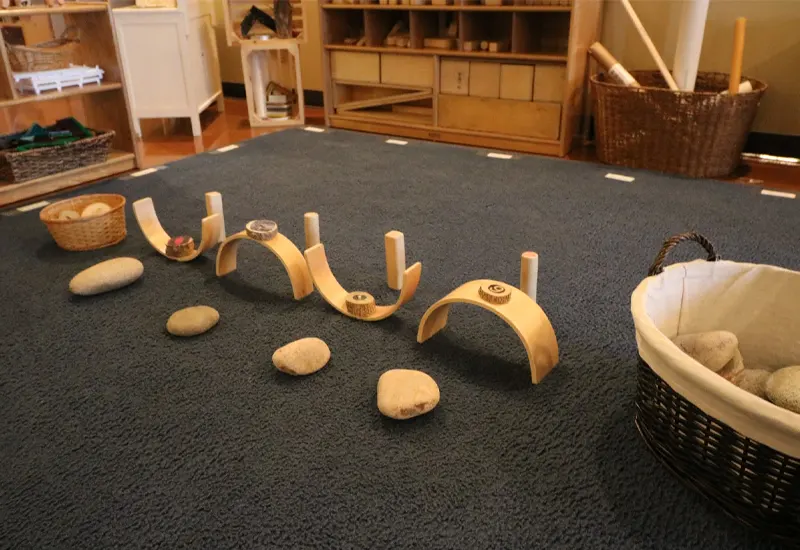
Recommended Furniture, Toys, and Materials
- Wooden building blocks of various sizes
- Loose parts (wheels, tubes, connectors)
- Construction sets such as magnetic tiles
- Measuring tools, rulers, and blueprints for planning
- Storage bins or shelves
- Safety helmets or gloves for thematic building play
Layout Suggestions: You can place this area on a hard floor surface for stability and easier cleanup. Ensure ample floor space for large structures, and provide nearby storage for loose parts and building tools.
Science and Nature Exploration Area
This trung tâm khoa học connects children with the natural world and encourages observation, experimentation, and inquiry. It supports scientific thinking by allowing children to investigate living things, natural phenomena, and cause-and-effect relationships.
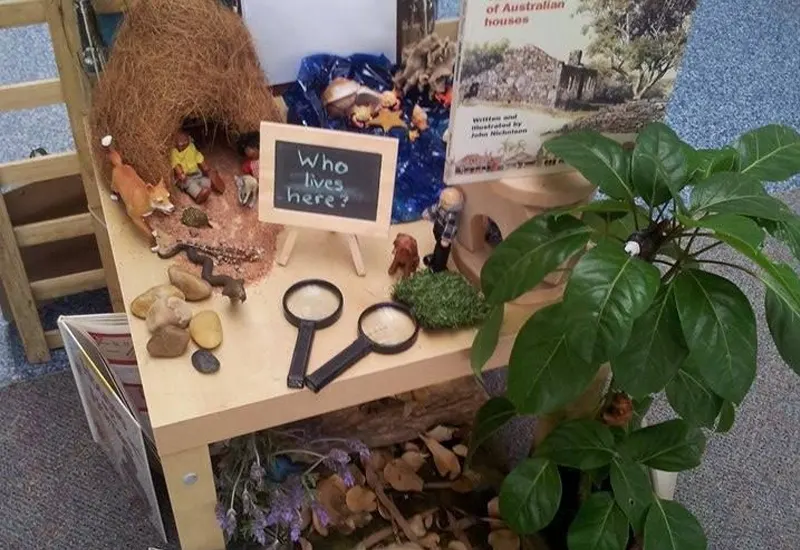
Recommended Furniture, Toys, and Materials
- Magnifying glasses and microscopes
- Jars or containers for collecting natural specimens
- Potted plants, seeds, and gardening tools
- Rocks, shells, feathers, and other nature finds
- Simple measuring and weighing tools
- Reference books about plants, animals, and habitats
Layout Suggestions: Place near a window to accommodate plants and natural light. Use child-height tables and magnifying tools so children can observe specimens closely. Incorporate seasonal elements to keep the space dynamic and relevant.
Light and Shadow Exploration Area
This area allows children to experiment with light sources, reflections, and shadows, fostering creativity and scientific discovery. It encourages questions about how light behaves and supports both art and science learning.
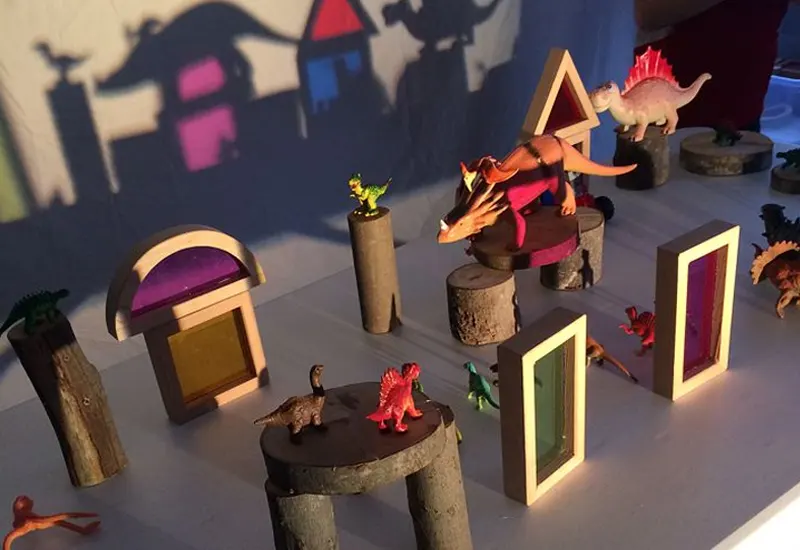
Recommended Furniture, Toys, and Materials
- Light table with translucent materials
- Projectors or overhead projectors
- Flashlights and colored filters
- Mirrors and reflective panels
- Transparent building blocks and shapes
- Shadow puppets and cut-out figures
Layout Suggestions: Position in a dimmable area or use partitions to control light levels. Include adjustable lamps, projectors, and reflective surfaces for experimentation.
Sensory Area
The sensory area offers experiences that engage touch, sight, sound, smell, and sometimes taste. It is particularly beneficial for self-regulation, concentration, and supporting children with different sensory processing needs. This space helps children explore textures, temperatures, and materials in a controlled, creative way.
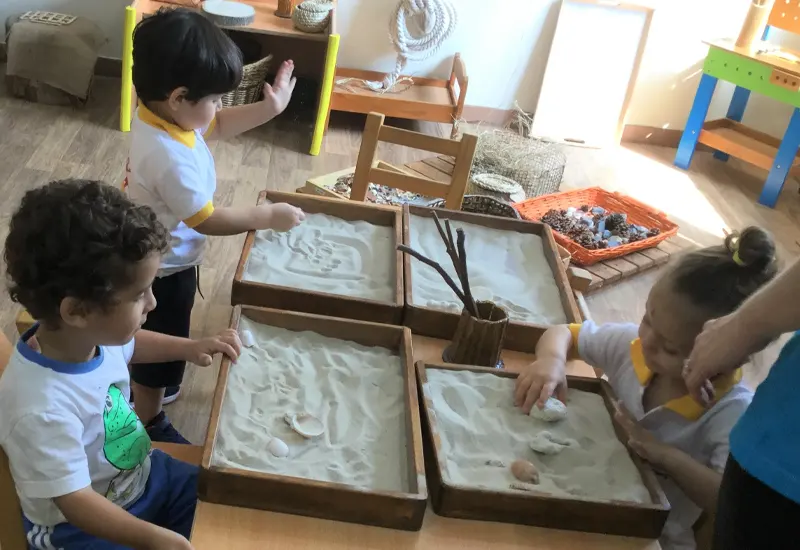
Recommended Furniture, Toys, and Materials
- Sand and water tables
- Sensory bins with rotating fillers
- Scoops, funnels, and containers
- Textured mats and panels
- Natural objects like pinecones, shells, or stones
- Musical instruments
Layout Suggestions: Situate the sensory area on a washable surface or near a sink for easy cleanup. Provide low tables or trays to contain materials, and rotate sensory resources regularly to keep the experience fresh.
Community & Gathering Space
The community and gathering space serve as the social and emotional heart of a Reggio Emilia classroom. It is where children come together for group discussions, storytelling, collaborative problem-solving, and celebrations. This area strengthens a sense of belonging, teaches children how to listen respectfully, and fosters the skills needed for cooperative decision-making.
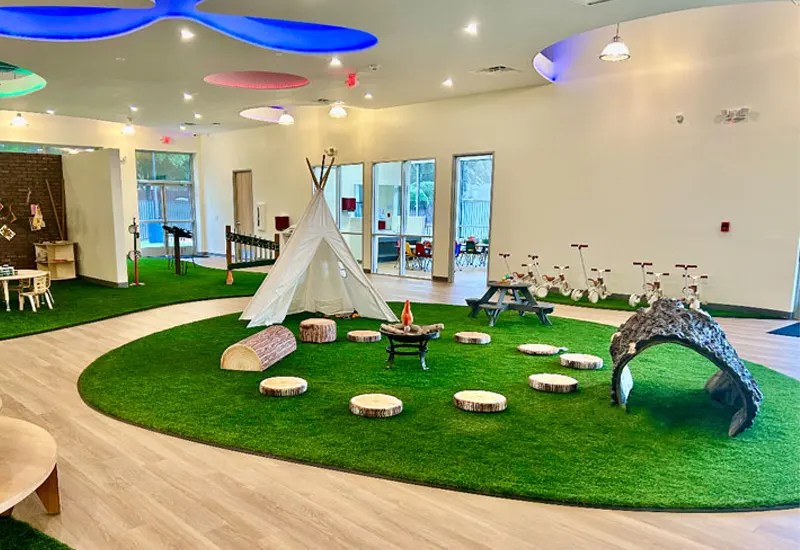
Recommended Furniture, Toys, and Materials
- Large rug for sitting together
- Low benches or stackable stools
- Display boards for group projects
- Musical instruments for collective music-making
- Circle-time props like talking sticks or puppets
- Visual schedules or community message boards
Layout Suggestions: Position the community and gathering space centrally so it is easily accessible from all learning zones. Ensure the area is free from permanent obstructions, allowing it to adapt to different activities. Maintain clear sightlines so educators can facilitate group interaction and ensure every child feels included.
Creating an Outdoor Reggio Emilia Classroom
Creating an outdoor Reggio Emilia classroom is about transforming a natural space into a dynamic, child-centered environment that reflects the same principles as the indoor classroom—beauty, intentionality, and responsiveness to children’s interests.
Outdoor learning offers unique benefits: it immerses children in nature, supports healthy physical development, fosters risk assessment skills, and inspires curiosity through direct sensory experiences. In this environment, children can observe seasonal changes, engage in hands-on exploration, and form deeper connections with the world around them.
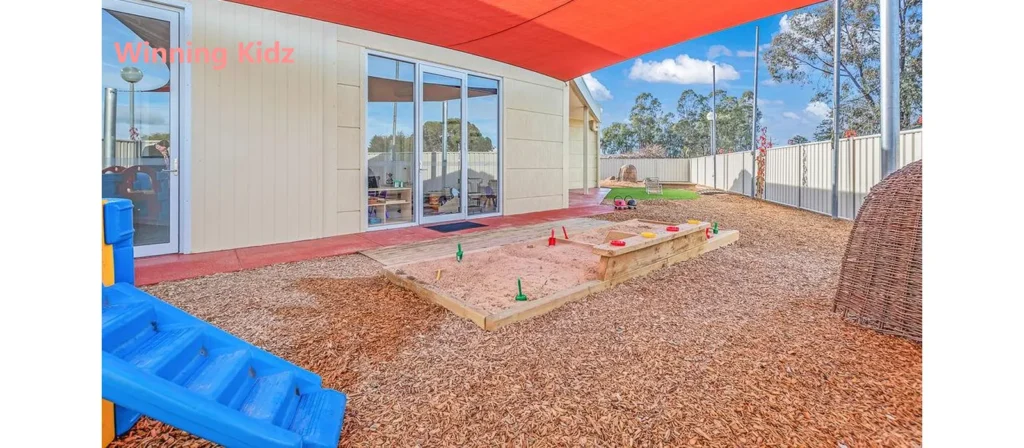
Recommended Items
- Gardening Zone: Raised beds, child-sized spades, rakes, and watering cans
- Loose Parts Play Area: Sticks, planks, rocks, and fabric for imaginative construction
- Outdoor Atelier: Easels, washable paints, brushes, and nature-inspired art materials
- Water and Sand Play: Basins, buckets, funnels, scoops, and sieves
- Gross Motor Zone: Balance beams, climbing logs, stepping stones, and rope ladders
- Observation Tools: Magnifying glasses, binoculars, bug catchers, and field guides
- Community Gathering Spot: Logs, benches, or mats for group meetings and storytelling
Design & Layout Suggestions
When designing an outdoor Reggio Emilia classroom, consider the balance between open, active spaces and quieter, reflective areas. Position messy play or water activities away from seating and dry work areas to maintain comfort. Integrate natural boundaries such as shrubs or logs to define different activity zones while keeping the space visually connected. Ensure all materials are weather-resistant and stored in accessible outdoor units to promote independence.
Considerations and Safety Tips
Designing an outdoor Reggio Emilia classroom requires balancing the freedom of open-ended exploration with the responsibility of maintaining a safe, inclusive environment. While nature provides rich learning opportunities, careful planning ensures the space remains secure, functional, and welcoming for all children.
- An toàn là trên hết: Regularly inspect climbing structures, pathways, and tools for hazards.
- Weather Readiness: Ensure the space can be used year-round by providing shaded areas, windbreaks, and rain shelters where possible.
- Supervision and Visibility: Arrange the space so educators can easily monitor all areas without interrupting play.
- Sustainability: Use reclaimed or eco-friendly materials where possible to model environmental responsibility.
- Material Rotation: Change out natural and loose parts regularly to keep curiosity alive.
What are the Must-haves in a Reggio Emilia Classroom?
A Reggio Emilia classroom is more than a room with desks and chairs—it’s a thoughtfully designed learning environment where every element serves a purpose in inspiring curiosity, fostering collaboration, and encouraging independence. The must-haves go beyond simple decoration; they include functional, flexible, and beautiful elements that align with the philosophy’s values.
Essential Daycare Furniture
The foundation of any Reggio Emilia classroom is child-sized, adaptable furniture that allows children to move freely and access resources independently. Furniture should be simple, sturdy, and made from natural materials to create a warm and inviting atmosphere. Its arrangement should also support flexible layouts so the classroom can evolve with ongoing projects.
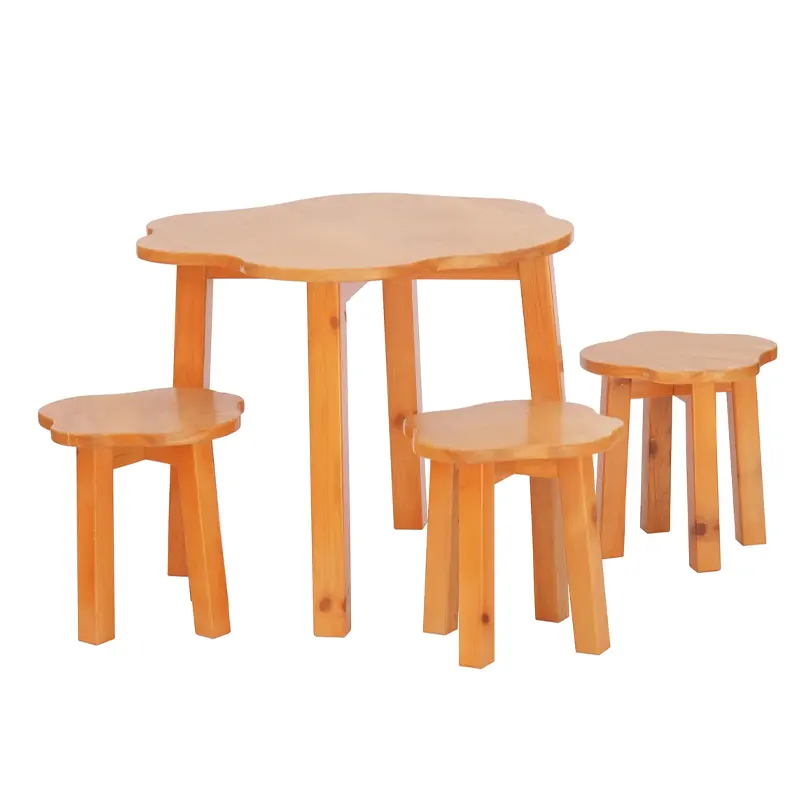
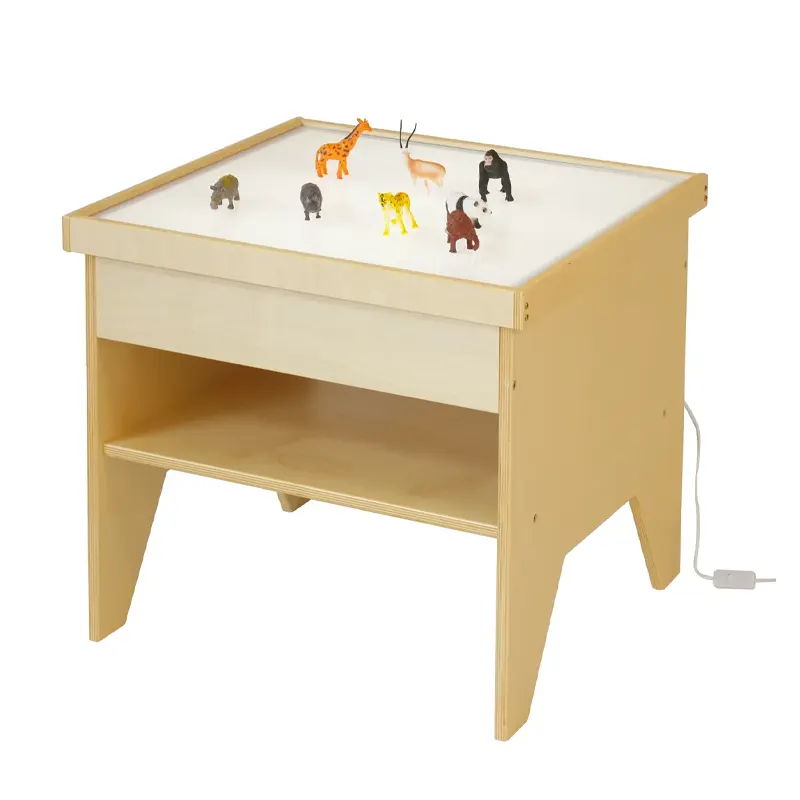
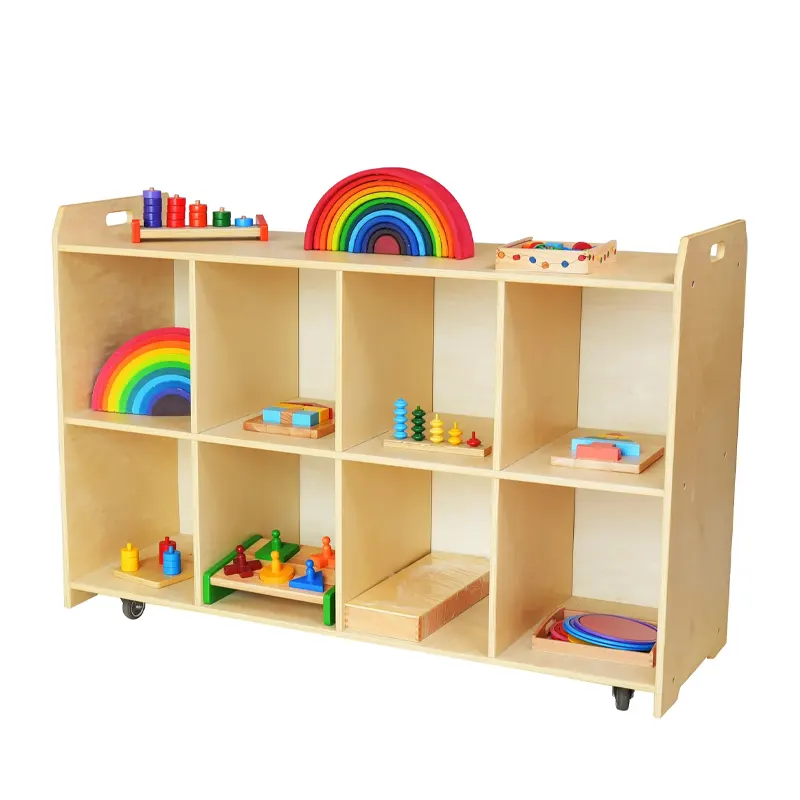
- Child-Sized Tables and Chairs: Encourage independence and comfort, making it easy for children to work individually or in groups.
- Movable Shelving Units: Open, low-level shelves for storing and displaying materials, allowing children to access resources without adult help.
- Flexible Seating Options: Cushions, benches, stools, and floor mats to support different learning activities and body positions.
- Display Panels and Boards: For showcasing children’s work, project documentation, and visual prompts.
- Storage Solutions: Baskets, trays, and bins to keep materials organized yet visible.
Recommended Educational Toys
In the Reggio Emilia approach, toys are not just for entertainment—they are learning tools that invite exploration and creativity. The focus is on open-ended toys that can be used in multiple ways, encouraging imagination, problem-solving, and cooperative play. These toys should be accessible and well-organized to empower children to make independent choices.

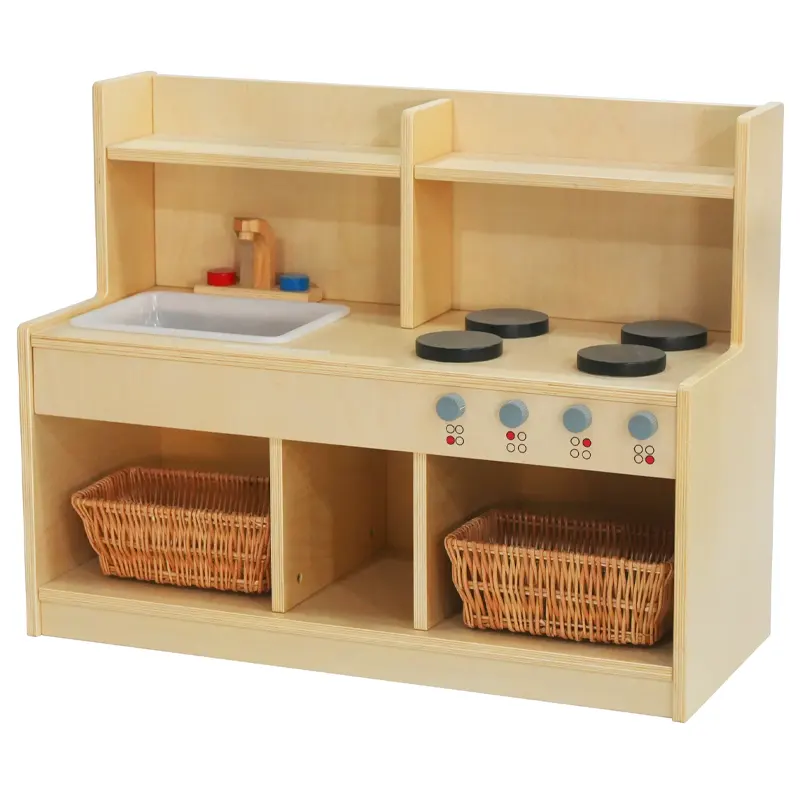
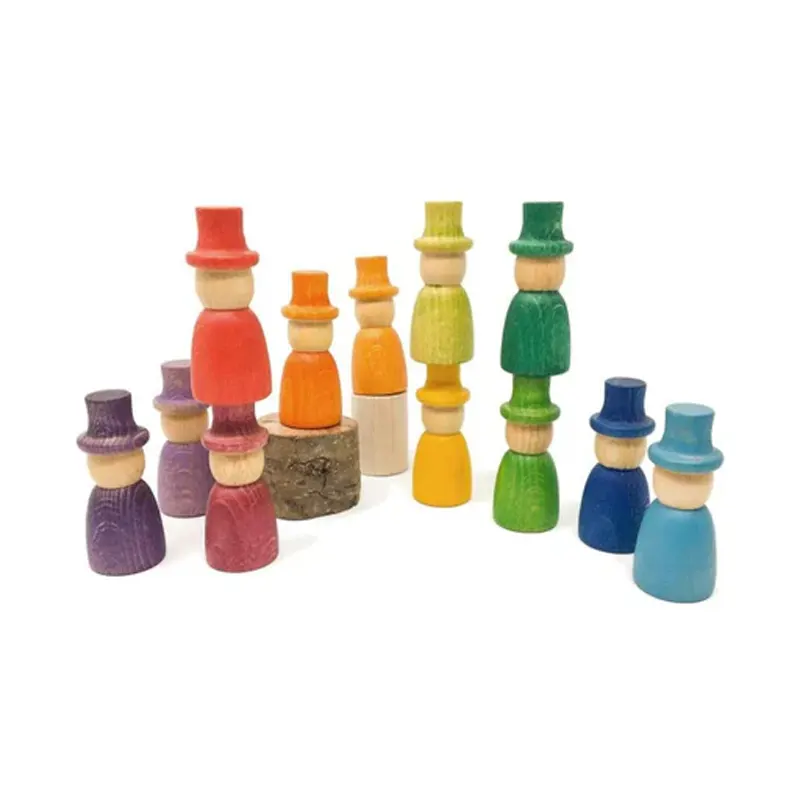
- Open-Ended Construction Sets: Wooden blocks, magnetic tiles, and loose parts to promote problem-solving and creativity.
- Role-Play Props: Kitchen sets, costumes, puppets, and pretend-play accessories for dramatic play.
- Science and Nature Tools: Magnifying glasses, balances, thermometers, and plant care equipment for investigation.
- Musical Instruments: Simple percussion instruments for rhythm activities and group music sessions.
Key Materials
Materials in a Reggio Emilia classroom serve as “languages” for children to express their ideas, document their thinking, and collaborate with peers. These should be aesthetically pleasing, sensory-rich, and often natural or recycled. They are the raw resources children use to build, create, and explore.
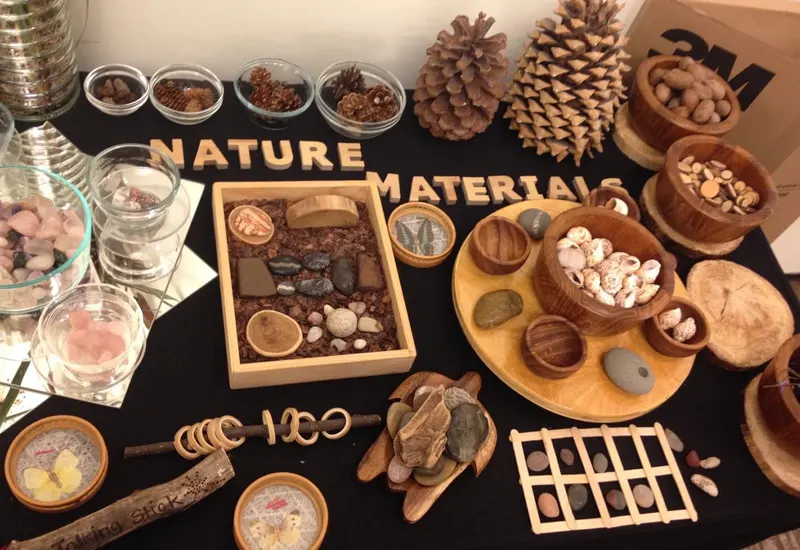
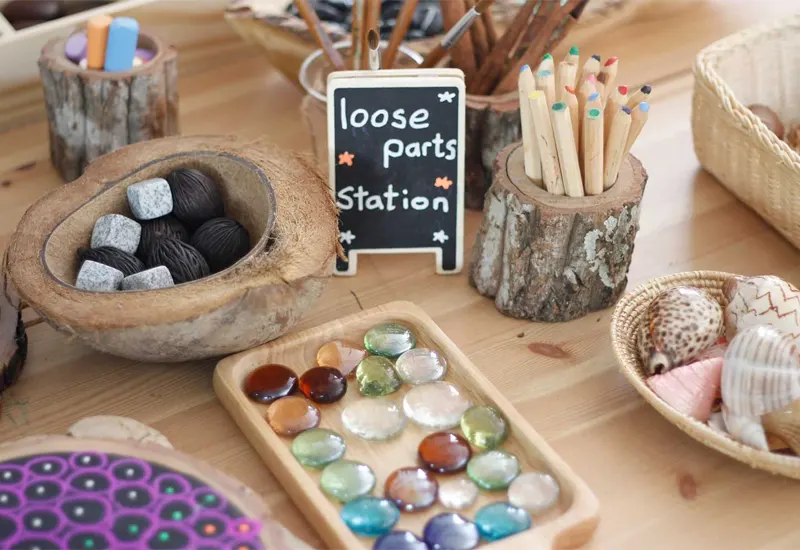
- Natural Elements: Wood, stones, shells, leaves, and other tactile materials that connect children to nature.
- Art Supplies: Paints, brushes, clay, collage materials, and light tables for creative exploration.
- Sensory Resources: Sand, water, rice, and fabric for hands-on discovery.
- Recycled and Loose Parts: Cardboard tubes, bottle caps, fabric scraps for imaginative building and designing.
Outdoor Equipment
Outdoor areas are a vital extension of the Reggio Emilia classroom, offering opportunities for large-motor play, environmental exploration, and hands-on interaction with nature. Outdoor equipment should promote creativity, physical development, and a connection with the natural world.
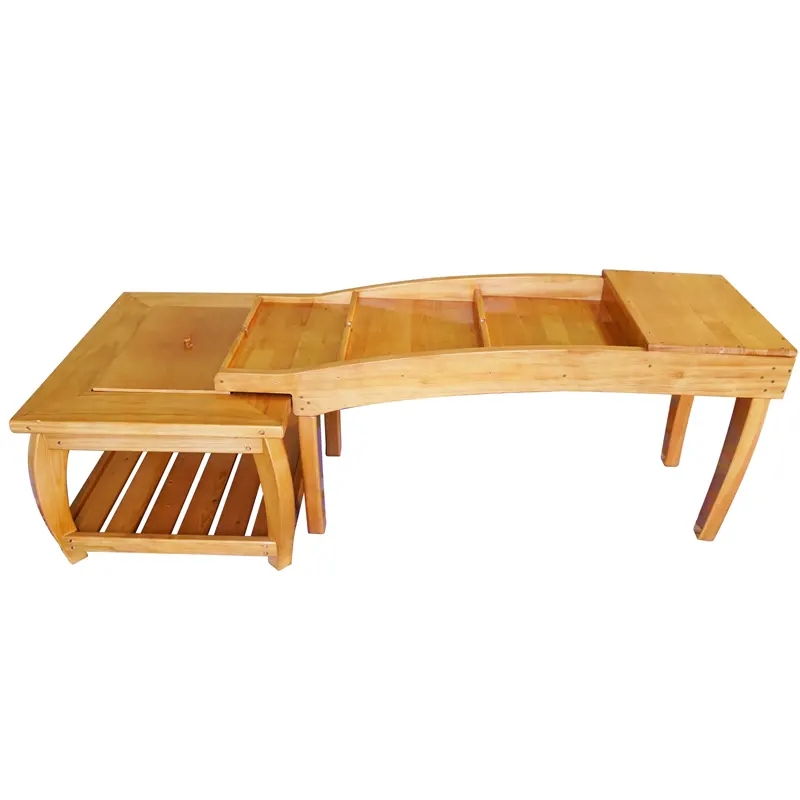
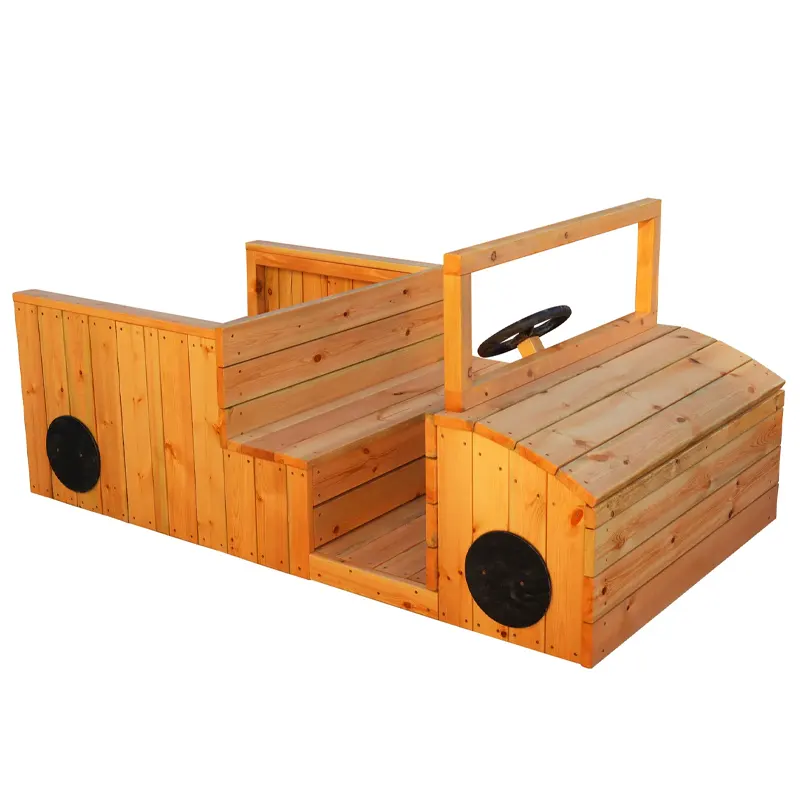
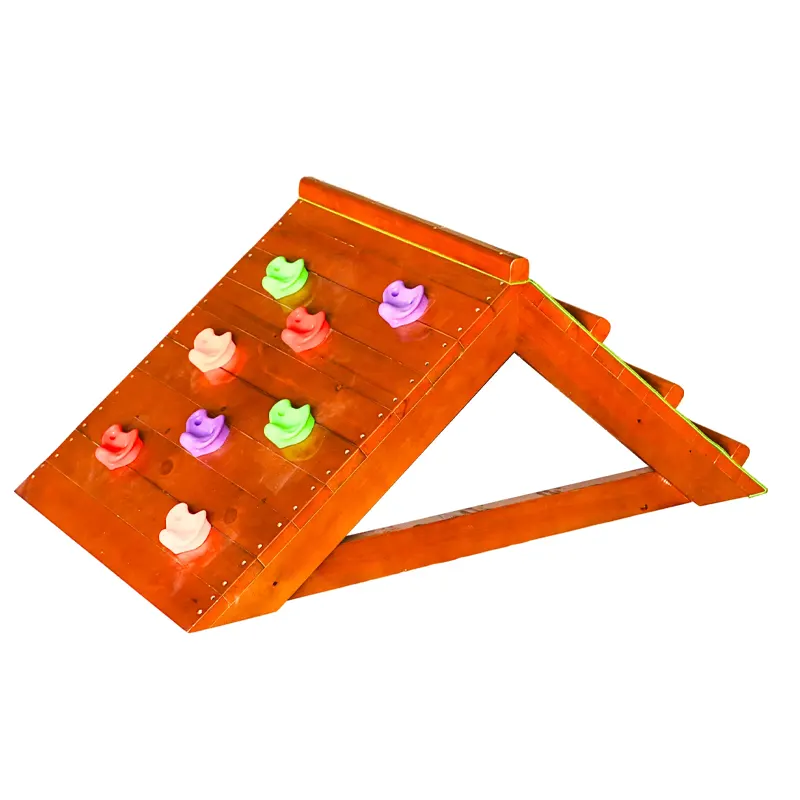
- Cấu trúc leo núi: Low climbing frames, balance beams, and stepping stones for physical development.
- Sand and Water Play Stations: Tables or pits with scoops, buckets, and funnels for sensory learning.
- Gardening Tools and Raised Beds: Child-sized spades, rakes, watering cans, and planters for hands-on nature work.
- Outdoor Loose Parts: Wooden planks, crates, logs, and tires for open-ended construction play.
- Weather Observation Tools: Thermometers, rain gauges, and wind vanes to support science exploration.
Hãy gửi tin nhắn cho chúng tôi nếu bạn có bất kỳ câu hỏi nào hoặc yêu cầu báo giá. Các chuyên gia của chúng tôi sẽ trả lời bạn trong vòng 48 giờ và giúp bạn chọn đúng sản phẩm bạn muốn.
Classroom Environment: Reggio Emilia Vs Montessori
While both the Reggio Emilia and Montessori approaches value child-centered learning, their classroom environments reflect different philosophies and priorities. Understanding these differences can help educators and parents choose or adapt an environment that aligns with their goals.
| Diện mạo | Reggio Emilia Classroom | Lớp học Montessori |
|---|---|---|
| Vai trò của môi trường | Viewed as the “third teacher,” designed to inspire exploration, collaboration, and creativity. | Prepared environment to promote independence, order, and concentration. |
| Layout | Flexible and changes according to current projects and children’s interests. | Consistent layout organized into curriculum areas (Practical Life, Sensorial, Language, Math, Cultural Studies). |
| Nguyên vật liệu | Open-ended, natural, and recycled materials with multiple uses. | Specialized, self-correcting materials designed for specific skills, each with a fixed place. |
| Display | Children’s work and project documentation are displayed prominently, highlighting the learning process. | Materials are displayed neatly on low shelves; children return items to their designated places after use. |
| Atmosphere | A dynamic, studio-like environment that evolves with children’s ideas. | Structured, orderly environment supporting sequential and independent learning. |
| Adaptability | Highly responsive to seasonal changes, project needs, and student interests. | Maintains a stable setup to reinforce routine and familiarity. |
Frequently Asked Questions about Reggio Emilia Classroom
What makes a Reggio Emilia classroom different from a traditional classroom?
Unlike traditional classrooms that often have fixed seating and teacher-led instruction, Reggio spaces feature open-ended materials, multiple activity zones, and layouts that encourage collaboration, creativity, and independence. The environment itself is considered an active participant in the learning process.
What is in a Reggio Emilia classroom?
A Reggio Emilia classroom contains flexible learning zones, natural and open-ended materials, and child-sized furniture. Common areas include an atelier for art, a dramatic play corner, a reading nook, construction and science exploration zones, and sometimes an outdoor learning space. The environment features plenty of natural light, displays of children’s work, and documentation panels that make learning visible.
How to set up a Reggio classroom?
Start by defining your educational goals and assessing the space for light, layout, and flow. Create distinct yet flexible zones for different types of exploration, using natural materials and child-accessible storage. Incorporate documentation areas at child height, ensure pathways are open for movement, and choose furniture that can be rearranged easily.
Where can I find furniture and materials for a Reggio Emilia classroom?
High-quality, durable furniture and open-ended materials are essential for this learning approach. Kidz chiến thắng offers a one-stop solution for educators, providing thoughtfully designed daycare furniture and toys that align perfectly with Reggio Emilia principles.
Phần kết luận
Designing a Reggio Emilia classroom is an intentional process of creating an environment that acts as a “third teacher,” fostering curiosity, collaboration, and independence. Every decision, from the placement of learning zones to the selection of materials, shapes how children explore, communicate, and grow.
From careful planning and flexible zoning to the intentional selection of natural, open-ended materials, each step contributes to a space that reflects the values of respect, beauty, and child-led exploration. By following a clear, step-by-step approach, educators can transform any space into a living, evolving classroom that adapts to children’s interests while fostering their creativity and critical thinking.
Kidz chiến thắng, as a trusted manufacturer and supplier of đồ nội thất nhà trẻ and toys, offers a comprehensive one-stop service to help bring a Reggio Emilia classroom vision to life. From versatile, child-friendly furniture to inspiring play materials, their solutions are designed to support educators in creating learning spaces where children feel empowered, capable, and excited to explore their world.

